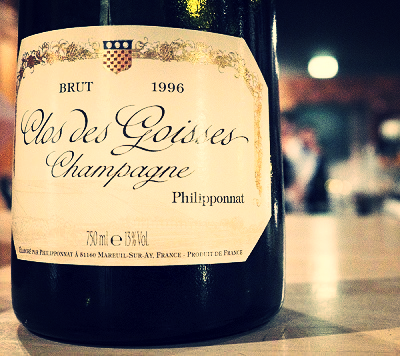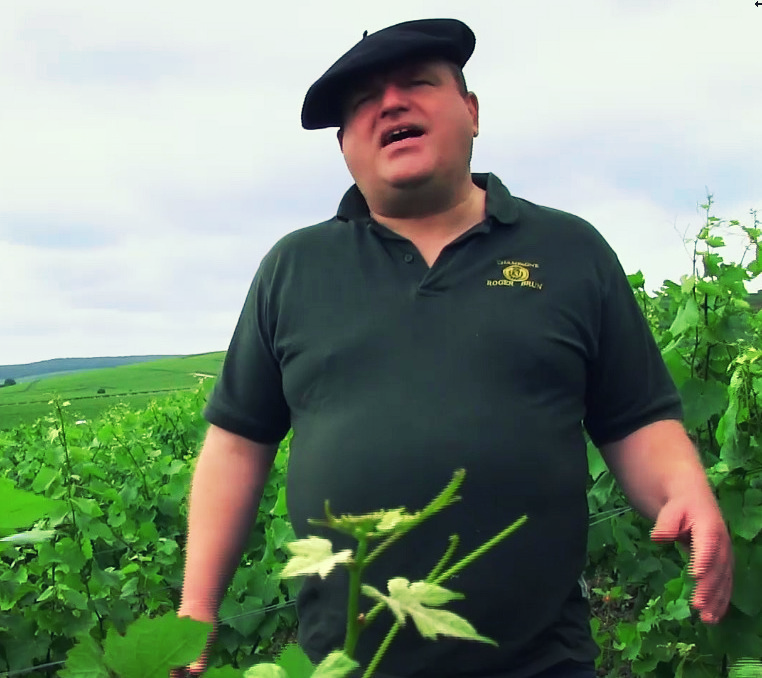Clos des Goisses
Let me let you in on a little secret: Clos des Goisses was the first single vineyard champagne that I have ever tasted. This happened about 12 years ago, at the private reception of a Sibelius concert in Bruges where they served a Clos des Goisses 1998. Not even a flute, but in a wineglass. This champagne was sensational with luxurious aromas of butterscotch, earth, toffee, freshly roasted Java coffee and cigar smoke. It tasted powerful, complex and vinous,yet also exquisitely refined and it lingered immensely long on the palate. Tasting this champagne gave me a similar sensation to enjoying one of the great red Burgundies and I felt like a king drinking it. A couple of years later, Philipponnat was the first champagne house that I visited when I started exploring the Champagne region. The president of the house (Charles) is now a friend of mine.
How it all began.
In Mareuil-sur-Aÿ the family Philipponnat goes all the way back to 1522. With experience in wine making since the end of the 17th century, Pierre Philipponnat founded the renowned champagne house in 1910. Nevertheless, it wasn't until 1935 that he acquired their crown jewel: the 5.5-hectare vineyard, Clos des Goisses. Over the course of the years, the company went through some organizational changes. In 1987 Champagne Philipponnat became a part of the Marie Brizard group (integrated into Bruno Paillard's Boizel Chanoine Champagne group in 1997). In 1999, a descendant from the Philipponnat family took the reins. Charles Philipponnat became president of Champagne Philipponnat. Charles, a hedonist and warm-hearted gentleman, got his passion for fine wines and gastronomy from his father René. Call it the cliché 'the apple doesn't fall far from the tree' personified. His father made legendary wines as chef de cave at Moët and Dom Pérignon. Together with his current cellarmaster Thierry Garnier, Charles Philipponnat lifted the Philipponnat champagnes to the next level.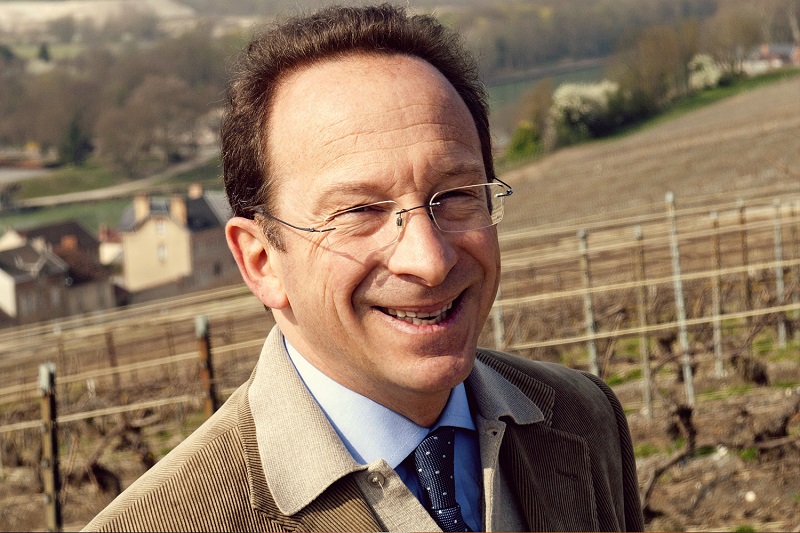
Charles Philipponnat | © www.philipponnat.com
What's in a name?
The prestige cuvée originally saw the light as "Vin des Goisses" in 1935. Yet, the family was charmed by the suggestion of Renaud Boudoin, a French journalist, to adapt the name to "Clos des Goisses". In 1959, they went ahead and changed the name. A good choice, since "Clos des Goisses" embodies everything about the terroir of this great cuvée. A "clos" being the French term for "a walled vineyard" and "goisses" regional slang for "very steep vineyards".The "goisses'' demand hard labour. With a gradient of 30 to 45 degrees, no tractors can be used to work the soil. Instead, they have to do it the old way: with horses pulling the ploughs and some plain old-fashioned manual labour.
The "clos" is located east of Mareuil-sur-Aÿ, on the north flank of the Marne river and the Canal Latéral. With an orientation completely towards the south the temperature rises about 1.5°C compared to the rest of the Champagne region. The result: a beneficiary microclimate. How does this work? First of all, the sun reflects its heat on the surface of the Marne river. Then, the thin clay-chalky surface works its magic as a natural solar collector. Meanwhile, the village buildings block the eastern winds that often carry rain. The roots of the vines therefore need to brace themselves and dig deep into the chalk soil in search of water. All this time, the walls of the clos perform their part as heat collectors. The combination of all of these allows the grapes to reach perfect maturity year after year. Nevermind chaptalization, when you have an average alcohol percentage of 11° - or more.
These climate conditions allowed Philipponnat to change their approach on the use of chemical treatments. Nowadays, for instance, after the ploughing, they let the grass grow back on the slopes, instead of using weed killers or weeding manually. However, Charles' aversion towards the use of copper has prevented the domaine from going 'organic". Until the present day, when necessary, small and limited amounts of synthetic products (including a bit of sulphur) are used to protect the vines against mildew and oïdium.
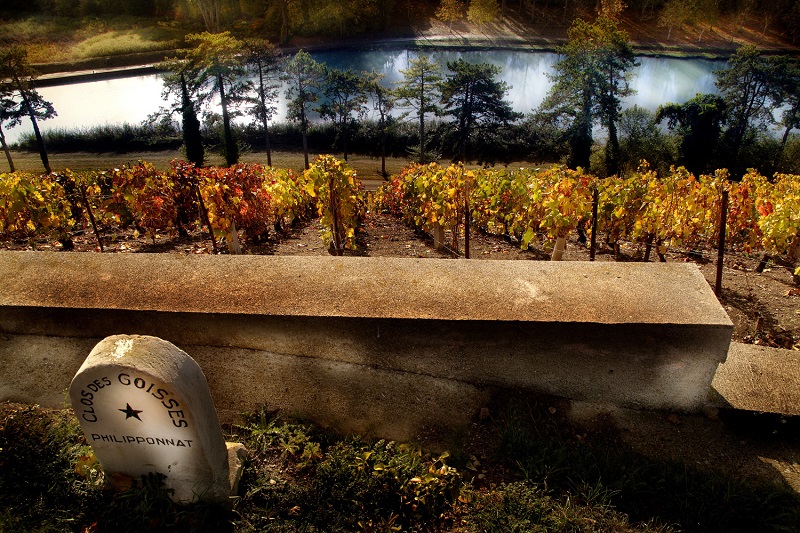
Clos des Goisses vineyard | © copyright www.philipponnat.com
Let's talk wine.
In the early days the vineyard was planted solely with Chardonnay. We had to wait till 1964 to taste the first Clos des Goisses' blend of Chardonnay and Pinot Noir. Most vintages now tend to be a blend of both containing a majority (60-70%) of Pinot Noir, except for the 1996 vintage that is fifty-fifty. Up 'till 1988, the wine was fermented in older oak barrels from Burgundy. Over the course of 1989-1998, the domain opted for enameled steel tanks and small oak casks. Only vintages 1999 and 2000 were produced entirely in stainless steel tanks. In 2001, they also acquired new 225-liter barrels, which are still used today. Malolactic fermentation has never been induced. Hence, the young wines are often austere, showing intense minerality and bitter toast with a sharp acidity. These wines need time to express their full potential. Therefore, decanting is recommended.Philipponnat champagnes managed to make some fabulous wines in off years like, 1991, 1992, 1997 and 2003. They even did in 2001, when few producers declared a vintage.
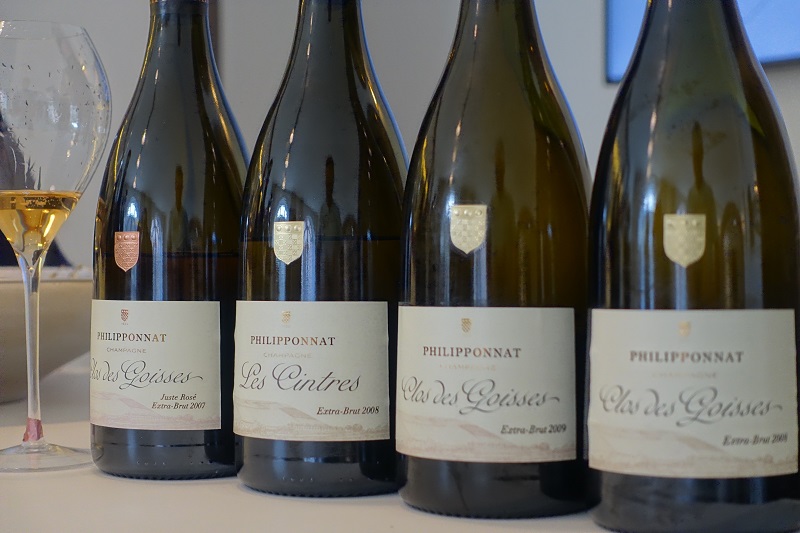
© The Champagnist
Something special
There are a couple of special éditions of Clos des Goisses. The L.V. ("long vieillissement") - reminiscent of Bollinger's R.D. - takes more time on the lees than the normal version. These wines are often fresher, more elegant as well as more complex. Some of these vinothèque wines stayed in contact with their yeasts for over 50 years.Les Cintres is a special cuvée made of Pinot Noir harvested from the center, and finest part, of Clos des Goisses. The cuvée vintage 2006 has been released in 2016 and the latest addition is a marvelous 2008.
Le Reflet grants its name to the shape of its bottle. This represents the silhouette you can admire from the opposite side of Clos des Goisses and le Canal Lathéral of the Marne river. Herefore, they blended an equal amount of Pinot Noir from Clos des Goisses with Chardonnay from the Côte des Blancs. This resulted in an elegant wine expressing a poised acidity with an excellent ageing potential. It's a true shame that they have stopped producing this cuvée.
Clos des Goisses Millénaire is the vintage 1990, in magnum, offered in a luxurious wooden box. Some of these bottles have sold at auctions for over 3,000 dollars. Finally, there's the Clos des Goisses rosé, "Juste Rosé". The word “Juste” refers to the color: "barely" a shade of pink. To the standard Clos des Goisses a small amount of macerated Pinot Noir (vinified as rosé de saignée) has been added to get a 'light copper-pink' wine. The production is limited to a maximum of 3,000 bottles. Quite honestly, the 2002 I tasted a couple of years ago, didn't blow my socks off. The vintage came across as rigid, unbalanced and even a bit clumsy. I haven't had the chance yet to retaste it and give it another go. Luckily, there is the 2006 vintage. This wine seduces with a sensual profile of a tropical fruit mix, throwing in some smokiness and minerality, finishing it off with a light tannic grip. Vintage 2007 is a true delight with a rich, smoky and at the same time mineral character. It's nearly as good as Bollinger La Grande Année 2007! This once again confirms that 2007 is a remarkable vintage for rosé champagnes.
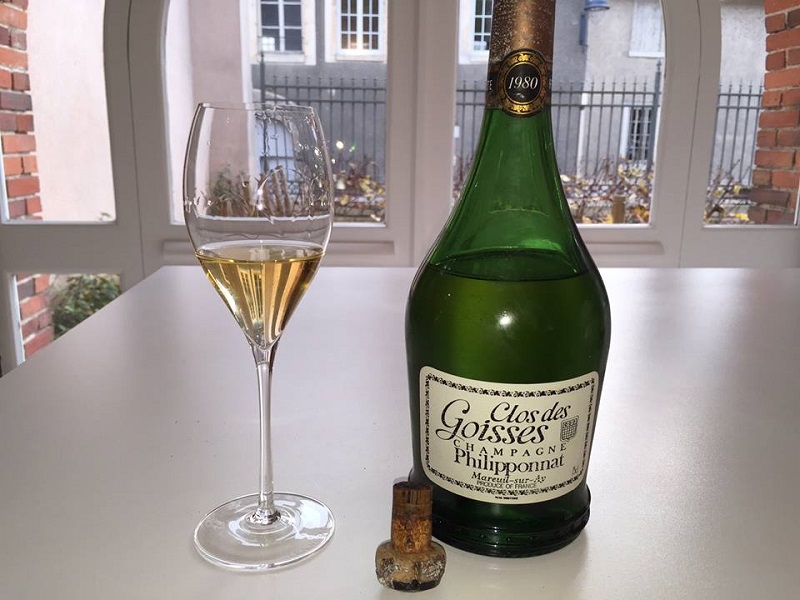
Credit: Charles Philipponnat Facebook photos
* I have tasted the Clos des Goisses wines on several occasions. Unfortunately, tasting one small glass is simply not enough to decently review a wine.
Therefore I chose not to include tasting notes of the vintages 1989 and 1976.
Therefore I chose not to include tasting notes of the vintages 1989 and 1976.
Clos des Goisses 2009 (last tasted July 2018) The nose is warm and rich, showing expressive Pinot Noir with notes of ripe peaches, prunes, confitures of plum and cassis, cocoa butter, lanoline, chocolate and armagnac. Swirling the glass, showed smoky notes of fireplace, salty Mont St Michel biscuits, straw and cigar case. The mouthfeel is vinous and full bodied, without losing structure and elegance. On the palate, you first get grilled peaches and apricot, followed by caramel, orange candy, cassis, blueberry and smoked meat on the mid-palate. There is a long finish with candied citrus, peach and deep toasty and yeasty flavors. This is already a beautiful Clos des Goisses to drink now, but the Pinot will only get even more expressive with time, probably resulting in deep chocolate and earthy flavors. Fabulous!
94 points with 95 potential
Clos des Goisses 2008 thé long awaited vintage. The nose is immensely complex, layered and surprisingly tropical: pineapple, pear, rambutan, mangosteen, green cardamom, bergamot orange, a typical tobacco scent, smokiness and chalk minerality. After a while in the glass, you get lovely creamy notes of cold Isigny cream with vanilla and a hint of forest berries. The mouthfeel is powerful while remaining fresh, dynamic and linear. On the palate, you get quince, Earl Grey tea, vague tropical flavors, mild spices, dried berries and vanilla. The finish is packed with layers of acidity (lemon, kumquat, lime, lemongrass) combined with mild spices (nutmeg, baking spices), smoke and toast. It's still a baby, but revealing enormous potential.
94 points with 97 potential
Les Cintres 2008 This Blanc de Noirs has an intense and complex nose of ginger, baked apples, quince, dried rhubarb, chichory root, tonka bean, forest berries and Burgundy wood. The mouthfeel is very rich, deep and vinous supported by an exquisite freshness. On the palate, this wine tastes very Burgundian with rosehip, smoke, earthyness, dark spices, dried blackberries, mature apples. On the mid-palate, we get candied citrus, pear and lemon. The finish is very long, spoiling us with tones of coffee, deep chalk, smoke and toast. When you use the very best of a vineyard then it doesn't come as a surprise that the result is an exceptional wine.
94 points with 96 potential
Clos des Goisses Juste Rosé 2007 (last tasted July 2018) This rosé has a very light copper color. The nose is warm and inviting with dried fruits (like cherry, peach and orange), tobacco and hints of tamarind and maracuja. After a while in the glass, you get old balsamico, parmesan, warm yeasty overtones, smoky notes and a haze of armagnac. The wine is creamy with mineral tension. On the palate, you get red cherry, raspberry, hazelnut, crunchy pastry a hint of nougat with honey and citrus fruits on the mid-palate. The finish is very long. It breathes sour cherry, grapefruit, tobacco and toast. All of this is supported by a complex minerality and smoky flavors that reverberate for a very long time. Fantastic to drink now, but can age a few more years..
94 points with 95 potential
Clos des Goisses 2007 - (Last tasted January 2018) - The wine has a lovely golden color with a fine effervescence. The nose is warm and inviting with hints of veal stock, mushrooms, soy sauce, dried flowers and woody spices. The mouthfeel is rich and vinous. The palate is already showing crème brulée, cognac and has unusual umami notes of mushroom sauce. On the mid palate the Pinot Noir is really shining with dark cherry, bramble and old apple. The finish is very long with tobacco, candied citrus, tamarind and honey. Although it is very dark and masculine in style, there is a lovely balanced acidity with enough freshness and structure. This wine pairs wonderfully with steak. The umami character, acidity and the fat create an explosion of harmonious flavors in your mouth.
94 points
Clos des Goisses Juste Rosé 2006 - (Last tasted January 2018) - This champagne has an elegant light copper, rose petal color with a very fine effervescence. The nose captivates with papaya, pomegranate, smoked pepper, blackberry, bergamot, forest strawberry, rosehip and mild toast. The mouthfeel is elegant, slightly vinous and a little bit tannic. On the palate, you find the same red fruits combined with candied orange, dried shallots, rose peppercorns, smoke and speculoos spices. The wine is remarkably well-balanced with a prolonged finish of tangerine, redcurrant, juniper berry and mild toast. This rosé champagne pairs wonderfully with pulled duck.
93 points
Clos des Goisses 2003 - (Last tasted October 2015) - The wine appeals with its golden color, refined effervescence and fat tears on the glass. In the nose you get dried apricot, brambleberry, flambeed pineapple, warm nougat and a haze of roasted coffee. After swirling the glass, we are spoiled by an intensely refined Chardonnay, reminding me of a top Montrachet. The mouthfeel is velvety with a creamy attack. Then, white cherries, soft mocha, dried apricot, smoke, honey and mild spices find their way to the palate. Ending with a very long finish of nougat, apricot, nectarine, dried pineapple and white pepper. This wine offers a profound minerality, which is very rare for the vintage. Personally, I like it even more than the Krug 2003, but ssssht, don’t tell anyone.
95 points
Clos des Goisses 2001 - (Last tasted November 2016) - The wine has a deep golden color with an elegant effervescence and nice tears on the glass. This is a dark, robust, powerful wine with a nose of musk, dried beef, baked apple, cognac, cigar smoke, dried porcini mushrooms, fenugreek, pumpernikel bread and grilled lemon. The champagne starts off intensely mineral with touches of clay and sea breeze. However, after some time in the glass, it reveals honey, old balsamico, caramel and marmite. The mouthfeel is bold and vinous. It has a lovely thick, fleshy fruit quality to it. On the palate, you discover a very expressively matured and honeyed Chardonnay: peach, toffee, milk chocolate and - unlike what the nose suggests - refined yeasts. The finish is long and toasty with an incredibly high acidity of lemon and gooseberry. I would give this wine at least another 10 years. This wine breathes energy. I have never had so much tension and complexity in a 2001. Most 2001s tend to lack structure and show a rather unpleasant acidity. This could very well be this vintage's best champagne.
93 points with 95 potential
Clos des Goisses 1998 - (Last tasted February 2018) - This is it, the wine that lit my passion for Clos de Goisses. The nose is very profound, austere and earthy. Truffle, marmite yeast, lovage, toasted hazelnuts, floral coffee, charred citrus; it's all there! It almost seems like the fruit was surpressed by the empyreumatic aromas. After a longer while in the glass, it shows stewed pears and Mirabel plums. The mouthfeel is vinous. The palate reminds me of a Bollinger R.D. 2002: dark spices, almost like an Indian curry backed-up by prunes, chestnut, toasted hazelnuts and deep chalk vain. The finish still projects a lot of acidity, but lacks a bit in fruit. The champagne has reached (and nearly passed) its peak. I would love to taste a 1998 L.V. version!
92 points
Clos des Goisses 1996 - (Last tasted January 2018) - Vintage 1996 is a legendary year for champagne. This champagne shows an intense and luminous golden color with a refined, elegant effervescence. In the nose, you get distinguished and layered aromas of an old Armagnac, candied lemon, roasted hazelnuts, orange blossom, asafoetida, fenugreek, straw, chestnut honey, smoke and oxidative overtones with deep supported by a dark, chalky minerality. After some time in the glass, aromas evolve towards expressive toast and cigar spices. The mouthfeel is very intense, dynamic and rich. The wine is very vinous, but remains crisp with a perfect mousse and tantalizing effervescence. The palate reminds of crème brûlée, quince paste, deep Armagnac, toffee, white truffle. On the mid-palate, we find complex spices with saline notes. The finish is immense: an acidity of citrus, pith fruits and apple - like a ballerina dancing on your tongue - embraced by warm spices, like lovage, fenugreek and fried onions. This is what champagne is all about!
96 points
Clos des Goisses 1995 - (Last tasted November 2016) - This champagne got an earlier disgorgement than average. It has a rich and mature nose of honeycomb, wax, lemon curd, walnuts, blueberry liqueur, cornflowers and a hint of absinthe. The mouthfeel is unctuous but still precise. On the palate you taste honey, lemon, dried mushrooms, toasted brioche and a hint of Fino sherry. The finish is long with woody spices, cigar and surprisingly linear citrus acidity.
94 points
Clos des Goisses 1995, L.V. - (last tasted May 2015)- This wine has a sensual nose of almond oil, red apple, lemon confit with salt, juicy pear, chamomile, lillies and very mild mineral notes. After some time in the glass it starts breathing butterscotch, cocoa butter, crusty baguette and a touch of mild cigar box. We get a polished wine without any sign of oxidation. On the palate, we distinguish toasted almond, pear, baked apple, toffee, blueberry, dried quince and a hint of chocolate. On the mid- palate, there is marzipan and honey. The acidity is round with a long finish of apple, candied lemon and delicate woody spices.
93 points
Clos des Goisses 1992 - (Last tasted September 2014) In the nose you get tamarind, passion fruit, mango, hazelnut, brioche, roasted apples, mushrooms and foliage. After a long time in the glas, aromas evolve to cigar smoke and the luxurious creaminess of an old Meursault. Not surprisingly, we get a very Burgundian, almost greasy mouthfeel. On the palate, we find tangerine, sweet grapefruit, preserved fruit (without being syrupy), hazelnut cream, vanilla and smoke. The wine has a very long finish with yellow fruits, toasted brioche. The whole is beautifully rounded and in perfect harmony. Together with the 1996, this is my favorite Clos des Goisses vintage.
96 points
Clos des Goisses 1991 - (Last tasted May 2016) In the past, I had some misfortune with corked bottles from this vintage, but last year I got lucky. The wine indulges with a complex nose of mango, petrol, cumin seeds, saffron, lovage, dried artichokes, smoke and a hint of caramel and toffee with a haze of Armagnac and earthy tones. On the palate, you get lots of tropical fruits, cream and Sauternes-like nectar. The vintage is very straightforward and powerful, maybe lacking a tad of elegance. There’s quite some alcohol warmth probably enhanced by the (very) high, yet perfectly integrated acidity. If I had tasted this wine blind, I would have pinned it down as a vintage 1990.
92 points
English text edited by Gudrun Huvelier
